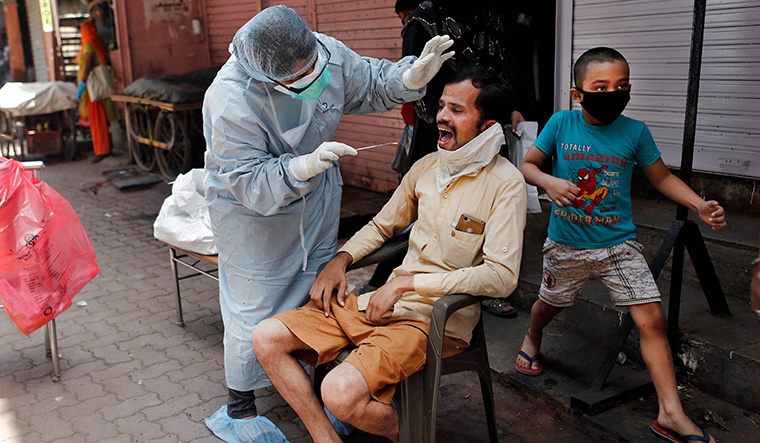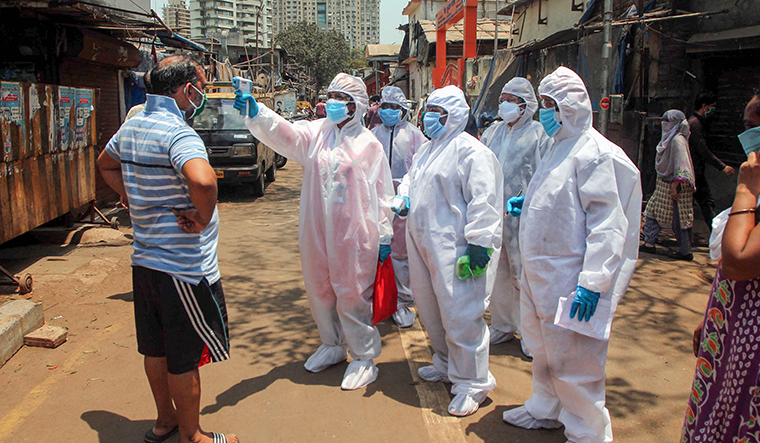Senior Inspector Vilas Gangawane and his team of 30 stood on high alert at the barricades at Shahu Nagar in Dharavi in Mumbai on April 20. The locality had registered its first Covid-19 case—a 56-year-old man with no travel history—three weeks earlier and, within 20 days, it became a hotspot with 180 cases and 12 deaths. “We have to man the barricades every single minute,” said Gangawane. “You never know from where the people might just escape. We cannot take any chances.”
On April 21, the city recorded 419 new cases, its biggest 24-hour jump. Maharashtra recorded 5,218 cases till April 22, and 66 per cent of them—3,451 cases—were in Mumbai. Around 85 per cent of the cases in Mumbai were from slums and semi-slum areas such as Dharavi, Worli Koliwada and Jijamata Nagar.
More than 40 per cent of the cases in Mumbai were in four wards—G-South, G-North, E and D. Much of these wards are slums with extremely high population density. In the G-South ward—covering Worli, Prabhadevi and Lower Parel—more than 3,500 people were under institutional quarantine. And, to accommodate them, Tourism Minister Aaditya Thackeray, the local MLA, got the National Sports Club of India dome, earlier a quarantine centre, to serve as a care centre for patients; it will take in more than 500 asymptomatic patients soon. Thackeray also got a phone booth-style swab-testing unit installed at Podar Hospital for cheap and early diagnosis.
In Mumbai, 42 per cent of the population dwells in slums, with almost 20,000 people in a square kilometre. “This is peculiar to Mumbai,” said Dr Nilesh Gawde, assistant professor, Tata Institute of Social Sciences. “The number of positive cases in the city is already high, and the worry is that it is going to spiral. There are so many people cramped together in slums, where many of them share space with 10 to 12 people in a 10x10m room. Most of them are workers holding jobs that cannot be done from home. Here, social distancing, rather physical distancing, is difficult to follow.”
The number of containment zones in the city went up from 77 to 813 in the first 22 days of April. “To ask people to follow social distancing in Mumbai is a joke in most localities,” said Kiran Dighavkar, assistant commissioner, Brihanmumbai Municipal Corporation. “We have found 12 to 15 people sleeping side by side in a dingy room. We simply ensure that people get food and medicines in their rooms and that they do not come out unnecessarily.”
Despite having better medical facilities than most parts of India, Mumbai’s mortality rate—4.81 per cent—is higher than the India average of 3.2 per cent.
The city’s health care system is under stress. As on April 20, almost 200 medical staffers across the city had tested positive for Covid-19. To limit the spread, hospitals with infected staff, including Wockhardt, Jaslok and Breach Candy, were sealed in the past weeks. This further shook people’s faith in the health care system. Only on April 21 did the BMC announce that the entire hospital would not be shut if a patient or employee tested positive.
“It was nightmarish when the hospital suddenly called saying that the dialysis unit was shutting down as the entire hospital had been sealed,” said young Sahil Kewat (name changed), who needs dialysis three times a week. “Just because two nurses tested positive, they sealed the entire hospital (Shushrusha) for almost a week. I was given no alternate lab for my dialysis. They said nobody would take me unless I proved that I was Covid-19 negative.”
Many hospitals are in a sad state. The BMC-run Kasturba Hospital, which has been at the forefront of the battle against Covid, lacks an ICU and a full-time intensivist. Videos of poor sanitation at SevenHills hospital have appeared on Twitter. It was more than a month after the first case was reported that the BMC-run Nair Hospital became the first hospital with an attached medical college to be designated a Covid-only facility. “The BMC never expected that the numbers would grow so fast,” said Dr Daksha Shah, health officer, BMC. “We were learning in the initial days and were trying to put things into perspective. Even the guidelines were not clear. We are a government setup and cannot give five-star treatment. We can contain the situation as we still have beds.”
Dr Om Shrivastav, an infectious disease specialist in the Maharashtra task force, said, “[It is] essential that all doctors from both public and private hospitals in the city come together. We need a bigger and stronger force. The government institutions cannot alone handle the crisis.”
A senior official said the cases could soon increase to a lakh, as the slums had already been hit. Said bioethics and global health researcher Dr Anant Bhan: “What went wrong in Mumbai is that the patients were spread across different hospitals and centres in the city, because obviously the government’s frontline hospitals were ill-prepared to suddenly handle a huge crisis. Because of this, many doctors and health staff got infected and hospitals had to be shut. Also, the hygiene and sanitation within hospitals has been questionable.”
The health care sector aside, ordinary Mumbaikars continue to grapple with the lockdown. With no jobs, little food and a clampdown in place, the migrant workers are yearning to go back to their villages. Chief Minister Uddhav Thackeray had asked them to stay calm and promised them food. “Why should we stay back?” asked Ramkrishna Yadav, a driver who lives in an 8x8m room in Mankhurd and has been giving free rides to those in need. “When everyone can be with their families inside the comfort of their homes, why can’t we? We do not get to go back before, during or after the lockdown. We have to struggle all our lives. This is our fate, isn’t it?”
Uncertainty and fear haunt everyone. As students wonder when their academic sessions will resume, professionals worry about layoffs. Anant Krishnamurthy, a 29-year-old working in a securities firm in Mumbai, said, “They might just cite a global economic meltdown as an excuse to fire us any moment.”
Deepa Ladhani, who lives in a chawl and sells homemade food, said orders had dried up because of the lockdown. “I get many orders on a daily basis and that is how I earn my living,” said the 35-year-old cook. “Now, as there is no transport, people know I would not be able to deliver. It is frustrating. Moreover, I fear that my son and I will catch the virus.”
Bollywood, too, has stalled. There is no activity in Film City in Goregaon; the technicians and workers have packed up. Release of big films such as Sooryavanshi and ‘83 has been postponed. “Every production house has been impacted in a major way, but we still have a sense of eternity ingrained in our systems,” said filmmaker Anand Tiwari. “We are helping daily wagers from our industry in every way we can. I feel that it will take us one and a half months, in addition to the lockdown period, for shoots to actually begin. One of the biggest challenges will be when the cinema halls and live theatres open, because the government will not allow people to watch movies as they used to. Social distancing will take precedence.”
With the city grappling with fear, its guardians, too, are facing the heat. Among units of Maharashtra Police, Mumbai Police have recorded the highest number of cases—15. But this has not stopped them from being on their toes. As on April 21, the eight-member Twitter team of Mumbai Police had responded to 20,000 tweets since the beginning of the lockdown.



